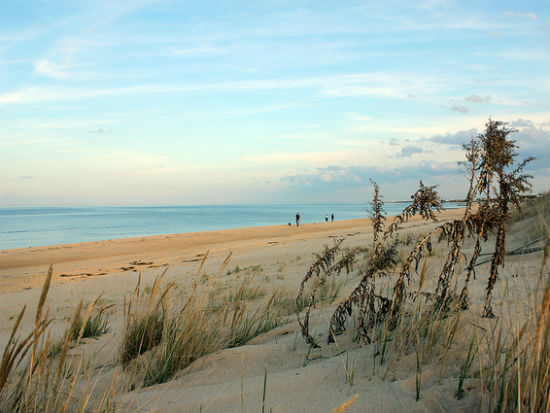Sea level rise cuts across political divide in Norfolk, Va.

Image by Doug Lewis via Flickr
While the climate change debate continues in some quarters in Washington, the impact of sea-level rise cut across political divides at the"Rising to the Challenge" conferencelast week in Norfolk, Va.. Members of Congress and Virginia mayors from both political parties joined military and state and local officials to discuss the challenges sea level rise presents to theHampton Roads area, as well as how to promote federal, state and local action.
Democratic U.S. Sen. Tim Kaine of Virginia, Republican U.S. Representatives Scott Rigell and Robert Wittman and Democratic Representative Robert Scott, Norfolk Mayor Paul Fraim (a Democrat) and Virginia Beach Mayor Will Sessoms (a Republican) joined Rear Admiral Jonathan White, Deputy Under Secretary of Defense John Conger and Alice Hill, senior advisor on the National Security Council. All called for coordination with all levels of government to move from technical discussion of sea-level rise to working policies.
"We cannot afford to do nothing. It is time to act," Sessoms said, underscoring that the impacts of climate change are not a political issue, but a backyard issuethreatening communities in Virginia.
The front lines of sea level rise
Coastal communities in southeast Virginia are at the front lines of sea-level rise. Sinking land and rising seas have combined to produce the fastest rates of sea-level rise along the U.S. East Coast for theHampton Roads region, comprising Virginia Beach, Norfolk, Hampton, and 14 other localities in Southeast Virginia. Sea levels have risen more than 14 inches(PDF)since 1930.
"Since it's our highest probability, highest impact threat, why don't we address it as such?" asked Norfolk's Director of Emergency Preparedness and Response Jim Redick when discussing the significance of sea-level rise. Hampton Roads is thesecond-most affectedby sea-level rise in the nation, and has the second-largest population center at risk from sea-level rise. Norfolk officials estimate the city will need at least $1 billion(PDF)in the coming decades to replace current infrastructure and keep water out of the city's homes and businesses.
Military is speaking up
Sea-level rise also threatens the region's numerous major military facilities, includingNaval Station Norfolk, the world's largest naval base and the most vulnerable such base to rising seas, according to Rear Admiral Kevin Slates.
 "This is a matter of national security," said the National Security Council's Hill. "It's a mission-readiness issue."
"This is a matter of national security," said the National Security Council's Hill. "It's a mission-readiness issue."
Rising seas also pose a threat to the region's economic health — about 46 percent(PDF)of the Hampton Roads economy comes from U.S. Defense Department spending.
This unique threat to the region has led the Department of Defense to partner with local and state government, local businesses and the community to work together on strategic, long-term regional planning on coastal resilience.
When pressed by panelists on how much sea-level rise the area will confront in the future, White explained that we can prevent the worst consequences if we address the root of climate change and "stop putting CO2in the atmosphere."
Bipartisan voices
The conference was the latest in a series of events demonstrating that climate changeneed not be a partisan issue. A report called"Risky Business: A Climate Risk Assessment for the United States,"released June 24 by former Secretary of Treasury Hank Paulson, formerNew York Mayor Michael Bloombergand entrepreneur Tom Steyer, provides acomprehensive valuation of financial risksthe United States faces from climate change.
While the report delves into agricultural, health and other climate impacts, it specifically calls out threats to coastal communities from sea-level rise and storm surges. It warns that within the next 15 years, higher sea levels alone likely will increase(PDF)the average annual cost of coastal storms along the eastern seaboard and Gulf of Mexico by $2 billion to $3.5 billion.
That risk was evident at the June 30 conference in Norfolk. "What is the cost if we don't do anything?" Sessoms asked. "I think we're going to see some numbers that are going to be staggering."
Sessoms's concernechoed testimony June 18from four Republican former EPA administrators before the Senate Environment and Public Works Committee on the urgent need for action on climate change. The former administrators also voiced their support of the Environmental Protection Agency'splan to regulate greenhouse gasesfrom existing power plants.
Moving from diagnosis to prescription
The "Rising to the Challenge" conference showed that on the local and state level, there is strong bipartisan support and agreement that the problem of sea-level-rise facing Hampton Roads, its citizens, property and assets is urgent. It demands action and commitment to work together on solutions. "We have to move from endless diagnosis to prescription," Kaine said.
The engaged community in Hampton Roads is united by a sense of urgency and poised to grapple with this threat. We hope leaders in Washington and elsewhere are watching this example of elected officials doing what they are meant to do: Working together to respond to their constituents' problems.
Top image of Norfolk beach by Doug Miller via Flickr. This article originally appeared atWorld Resources Instituteand is reprinted with permission.


